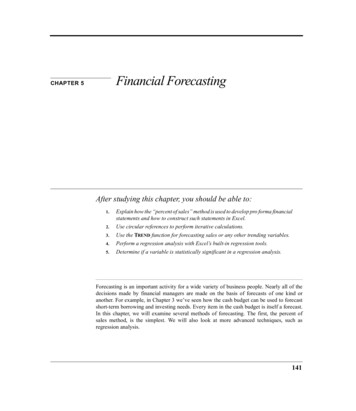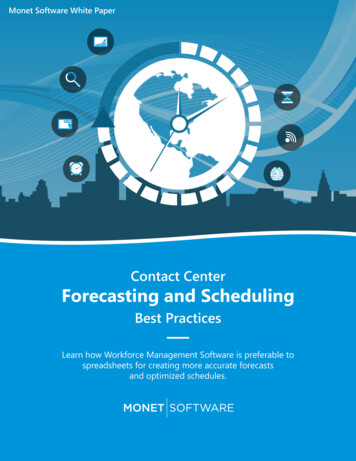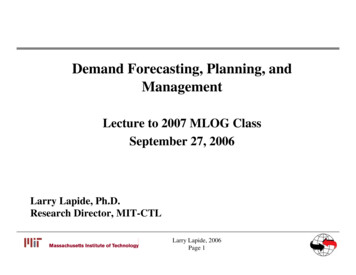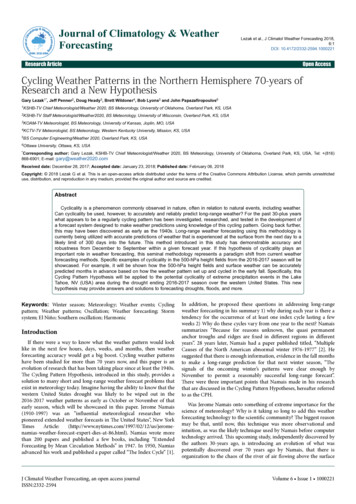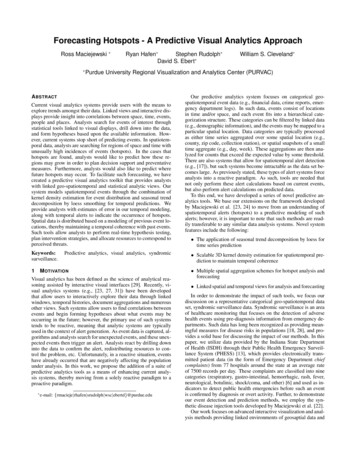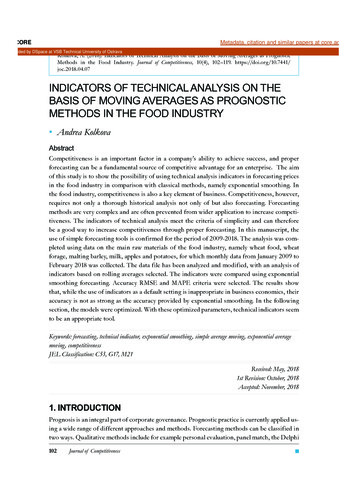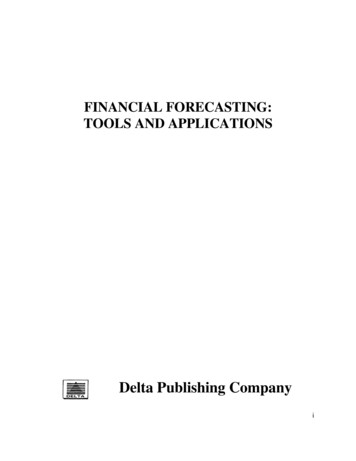
Transcription
FINANCIAL FORECASTING:TOOLS AND APPLICATIONSDelta Publishing Companyi
Copyright2008 byDELTA PUBLISHING COMPANYP.O. Box 5332, Los Alamitos, CA 90721-5332All rights reserved. No part of this course may bereproduced in any form or by any means, withoutpermission in writing from the publisher.ii
PREFACEBusiness forecasting is of extreme importance to managers at practically all levels. It is required fortop managers to make long-term strategic decisions. Middle management uses sales forecasts todevelop their departmental budgets. Every other plan such as a production plan, purchasing plan,manpower plan, and financial plan follows from sales forecasting. The course is designed forbusiness professionals such as director of forecasting and planning, forecast manager, director ofstrategic planning, director of marketing, sales manager, advertising manager, CFO, financialofficer, controller, treasurer, financial analyst, production manager, brand/product manager, newproduct manager, supply chain manager, logistics manager, material management manager,purchasing agent, scheduling manager, and director of information systems.The goal of this course is to provide a working knowledge of the fundamentals of businessforecasting that can be applied in the real world regardless of firm size. We walk you through basicforecasting methodology, and then practical applications. All aspects of business forecasting arediscussed making this course a comprehensive, valuable reference.What is unique about this course is threefold. First, this course is practically oriented. It willtry to avoid theoretical, rigorous, and mathematical discussions. It will directly get into how to useit, when to use, what it is used for, and what resources are required of it. It will include manypractical examples, applications, illustrations, guidelines, measures, checklists, rules of thumb,"tips," graphs, diagrams, and tables to aid your comprehension of the subject.Secondly, it incorporates the use of computer technology--especially PC. Actual computerprintouts obtained via spreadsheet programs such as Microsoft' Excel, Lotus 1-2-3, Quattro Pro,Spreadsheet-based add-ins (such as Budget Maestro), and, and popular software packages such asSPSS, Minitab, and SAS, are be displayed and explained.Thirdly, the course goes much beyond just sales forecasting. It encompasses a wide range oftopics of major importance to practical business managers, including economic forecasting, cashflow forecasting, cost prediction, earnings forecasts, bankruptcy prediction, foreign exchangeforecasting, interest rate forecasting, and much more.iii
TABLE OF CONTENTSPREFACEPART IINTRODUCTIONCHAPTER 1 FORECASTING AND MANAGERIAL PLANNINGCHAPTER 2 FORECASTING, BUDGETING, AND BUSINESS VALUATIONPART IIFORECASTING METHODSCHAPTER 3 MOVING AVERAGES AND SMOOTHING METHODSCHAPTER 4 REGRESSION ANALYSISCHAPTER 5 MULTIPLE REGRESSIONCHAPTER 6 TIME SERIES ANALYSIS AND CLASSICAL DECOMPOSITIONCHAPTER 7 FORECASTING WITH NO DATA AND LONG RANGE FORECASTINGCHAPTER 8 INDIRECT METHODSCHAPTER 9 EVALUATION OF FORECASTSCHAPTER 10 WHAT IS THE RIGHT FORECASTING TOOL AND SOFTWARE FOR YOU?PART IIIAPPLICATIONSCHAPTER 11 SALES AND REVENUE FORECASTINGCHAPTER 12 FORECASTING THE ECONOMYCHAPTER 13 FINANCIAL AND EARNINGS FORECASTINGCHAPTER 14 CASH FLOW FORECASTINGCHAPTER 15 ANALYSIS OF COST BEHAVIOR AND COST PREDICTIONCHAPTER 16 BANKRUPTCY PREDICTIONSCHAPTER 17 FORECASTING FOREIGN EXCHANGE RATESCHAPTER 18 INTEREST RATE FORECASTINGCHAPTER 19 TECHNOLOGICAL FORECASTINGCHAPTER 20 FORECASTING IN THE 21ST CENTURYGLOSSARYAPPENDIXiv
CHAPTER 1FORECASTING AND MANAGERIAL PLANNINGLearning Objectives:After completing this chapter, you should be able to:1.2.3.4.5.6.Define what a forecast is.Discuss how a forecast relates to managerial planning.Identify who uses forecasts.Explain the types of forecasts.Compare various forecasting methods and discuss how to select the right method.Explain what is involved in the forecasting process.Management in both private and public organizations and in both manufacturing and serviceorganizations typically operate under conditions of uncertainty or risk. Probably the most importantfunction of business is forecasting. A forecast is a starting point for planning. The objective offorecasting is to reduce risk in decision making. In business, forecasts are the basis for capacityplanning, production and inventory planning, manpower planning, planning for sales and marketshare, financial planning and budgeting, planning for research and development and topmanagement's strategic planning. Sales forecasts are especially crucial aspects of many financialmanagement activities, including budgets, profit planning, capital expenditure analysis, andacquisition and merger analysis.Figure 1.1 illustrates how sales forecasts relate to various managerial functions of business.WHO USES FORECASTS?Forecasts are needed for marketing, production, purchasing, manpower, and financial planning.Further, top management needs forecasts for planning and implementing long-term strategicobjectives and planning for capital expenditures.Marketing managers use sales forecasts to determine (1) optimal sales force allocations, (2)set sales goals, and (3) plan promotions and advertising. Other things such as market share, prices,and trends in new product development are required.Production planners need forecasts in order to:.Schedule production activities.Order materials.Establish inventory levels1
.Plan shipmentsFIGURE 1.1SALES FORECASTS AND MANAGERIAL FUNCTIONSProduction/operations managers need long-range forecasts to make strategic decisions aboutproducts, processes, and facilities. They also need short-range forecasts to assist them in makingdecisions about production issues that span only the next few weeks. Table 1.1 cites some examplesof things that are commonly forecasted. Long-range forecasts usually span a year or longer andestimate demand for entire product lines such as lawn products. Medium-range forecasts usuallyspan several months and group products into product families such as lawn mowers. Short-rangeforecasts usually span a few weeks and focus on specific products such as lawn mower model #101.Some other areas that need forecasts include material requirements (purchasing andprocurement), labor scheduling, equipment purchases, maintenance requirements, and plantcapacity planning. Managers are also interested in forecasting costs, prices, and delivery times.As shown in Figure 1.1, as soon as the company makes sure that it has enough capacity, theproduction plan is developed. If the company does not have enough capacity, it will requireplanning and budgeting decisions for capital spending for capacity expansion.On this basis, the financial manager must estimate the future cash inflow and outflow. Hemust plan cash and borrowing needs for the company's future operations. Forecasts of cash flowsand the rates of expenses and revenues are needed to maintain corporate liquidity and operatingefficiency. In planning for capital investments, predictions about future economic activity arerequired so that returns or cash inflows accruing from the investment may be estimated.2
TABLE 1.1FORECAST VARIABLES AND TIME HORIZONForecasts must also be made of money and credit conditions and interest rates so that thecash needs of the firm may be met at the lowest possible cost. The finance and accounting functionsmust also forecast interest rates to support the acquisition of new capital, the collection of accountsreceivable to help in planning working capital needs, and capital equipment expenditure rates tohelp balance the flow of funds in the organization. Sound predictions of foreign exchange rates areincreasingly important to financial managers of multinational companies (MNCs).Long-term forecasts are needed for the planning of changes in the company's capitalstructure. Decisions as to whether to issue stock or debt in order to maintain the desired financialstructure of the firm require forecasts of money and credit conditions.The personnel department requires a number of forecasts in planning for human resourcesin the business. Workers must be hired and trained, and for these personnel there must be benefitsprovided that are competitive with those available in the firm's labor market. Also, trends that3
affect such variables as labor turnover, retirement age, absenteeism, and tardiness need to beforecast as input for planning and decision making in this function.Managers of nonprofit institutions and public administrators must also make forecasts.Hospital administrators face the problem of forecasting the health care needs of the community. Inorder to do this efficiently, a projection has to be made of:The growth in absolute size of populationThe changes in the number of people in various age groupingsThe varying medical needs these different age groups will have.Universities forecast student enrollments, cost of operations, and in many cases, what levelof funds will be provided by tuition and by government appropriations.Forecasting is also important to managers of service organizations. For example, managersin the travel and tourism industry need seasonal forecasts of demand. City planners need forecastsof population trends in order to plan highways and mass transit systems, and restaurants needforecasts in order to be able to plan for food purchases. The service sector which today account for70 percent of the U.S. gross domestic product (GDP), including banks, insurance companies, andcruiseships, need various projections for their operational and long-term strategic planning. Take abank, for example. The bank has to forecast:Demands of various loans and depositsMoney and credit conditions so that it can determine the cost of money it lendsTYPES OF FORECASTSThe types of forecasts used by businesses and other organizations may be classified in severalcategories, depending on the objective and the situation for which a forecast is to be used. Fourtypes are discussed below.SALES FORECASTSAs discussed in the previous section, the sales forecast gives the expected level of sales for thecompany's goods or services throughout some future period and is instrumental in the company'splanning and budgeting functions. It is the key to other forecasts and plans.ECONOMIC FORECASTSEconomic forecasts, or statements of expected future business conditions, are published bygovernmental agencies and private economic forecasting firms. Business can use these forecastsand develop its own forecasts about external business outlook that will affect its product demand.Economic forecasts cover a variety of topics including GDP, levels of employment, interest rates,and foreign exchange rates.4
FINANCIAL FORECASTSAlthough the sales forecast is the primary input to many financial decisions, some financialforecasts need to be made independently of sales forecasts. This includes forecasts of financialvariables such as the amount of external financing needed, earnings, and cash flows and predictionof corporate bankruptcy.TECHNOLOGICAL FORECASTSA technological forecast is an estimate of rates of technological progress. Certainly, softwaremakers are interested in the rates of technological advancement in computer hardware and itsperipheral equipment. Technological changes will provide many businesses with new products andmaterials to offer for sale, while other companies will encounter competition from other businesses.Technological forecasting is probably best performed by experts in the particular technology.FORECASTING METHODSThere is a wide range of forecasting techniques that the company may choose from. There arebasically two approaches to forecasting: qualitative and quantitative. They are as follows:1. Qualitative approach - forecasts based on judgment and opinion.(1)(2)(3)(4)Executive opinionsDelphi techniqueSales force pollingConsumer surveys2. Quantitative approacha) Forecasts based on historical data Naive methods Moving averages Exponential smoothing Trend analysis Decomposition of time seriesb) Associative (Causal) forecasts Simple regression Multiple regression Econometric modelingc) Indirect methods Market surveys Input-output analysis Barometric forecasting5
Forecasts based on consumer behavior - Markov approachFigure 1.2 summarizes the forecasting methods.Quantitative models work superbly as long as little or no systematic change in theenvironment takes place. When patterns or relationships do change, by themselves, the objectivemodels are of little use. It is here where the qualitative approach based on human judgment isindispensable. Because judgmental forecasting also bases forecasts on observation of existingtrends, they too are subject to a number of shortcomings. The advantage, however, is that they canidentify systematic change more quickly and interpret better the effect of such change on the future.We will discuss the qualitative method here in this chapter, while various quantitativemethods along with their illustrations will be taken up in subsequent chapters.FIGURE 1.2FORECASTING METHODSSELECTION OF FORECASTING METHODThe choice of a forecasting technique is significantly influenced by the stage of the product lifecycle, and sometimes by the firm or industry for which a decision is being made.6
In the beginning of the product life cycle, relatively small expenditures are made forresearch and market investigation. During the first phase of product introduction, theseexpenditures start to increase. In the rapid growth stage, considerable amounts of money areinvolved in the decisions; therefore a high level of accuracy is desirable. After the product hasentered the maturity stage, the decisions are more routine, involving marketing and manufacturing.These are important considerations when determining the appropriate sales forecast technique.After evaluating the particular stages of the product, and firm and industry life cycles, afurther probe is necessary. Instead of selecting a forecasting technique by using whatever seemsapplicable, decision makers should determine what is appropriate. Some of the techniques are quitesimple and rather inexpensive to develop and use, whereas others are extremely complex, requiresignificant amounts of time to develop, and may be quite expensive. Some are best suited forshort-term projections, whereas others are better prepared for intermediate- or long-term forecasts.What technique or techniques to select depends on the following criteria:1. What is the cost associated with developing the forecasting model compared withpotential gains resulting from its use? The choice is one of benefit-cost trade-off.2. How complicated are the relationships that are being forecasted?3. Is it for short-run or long-run purposes?4. How much accuracy is desired?5. Is there a minimum tolerance level of errors?6. How much data are available? Techniques vary in the amount of data they require.THE QUALITATIVE APPROACHThe qualitative (or judgmental) approach can be useful in formulating short-term forecasts and alsocan supplement the projections based on the use of any of the quantitative methods. Four of thebetter known qualitative forecasting methods are Executive Opinions, the Delphi Method, SalesForce Polling, and Consumer Surveys.EXECUTIVE OPINIONSThe subjective views of executives or experts from sales, production, finance, purchasing andadministration are averaged to generate a forecast about future sales. Usually this method is used inconjunction with some quantitative method such as trend extrapolation. The management teammodifies the resulting forecast based on their expectations.The advantage of this approach is that the forecasting is done quickly and easily, withoutneed of elaborate statistics. Also, the jury of executive opinions may be the only feasible means offorecasting in the absence of adequate data. The disadvantage, however, is that of "group think."This is a set of problems inherent to those who meet as a group. Foremost among these problemsare high cohesiveness, strong leadership, and insulation of the group. With high cohesiveness, thegroup becomes increasingly conforming through group pressure which helps stifle dissension and7
critical thought. Strong leadership fosters group pressure for unanimous opinion. Insulation of thegroup tends to separate the group from outside opinions, if given.THE DELPHI METHODIt is a group technique in which a panel of experts is individually questioned about their perceptionsof future events. The experts do not meet as a group in order to reduce the possibility that consensusis reached because of dominant personality factors. Instead, the forecasts and accompanyingarguments are summarized by an outside party and returned to the experts along with furtherquestions. This continues until a consensus is reached by the group, especially after only a fewrounds. This type of method is useful and quite effective for long-range forecasting.The technique is done by "questionnaire" format and thus it eliminates the disadvantages ofgroupthink. There is no committee or debate. The experts are not influenced by peer pressure toforecast a certain way, as the answer is not intended to be reached by consensus or unanimity. Lowreliability is cited as the main disadvantage of the Delphi Method, as well as lack of consensus fromthe returns.SALES-FORCE POLLINGSome companies use as a forecast source sales people who have continual contacts with customers.They believe that the sales force that is closest to the ultimate customers may have significantinsights regarding the state of the future market. Forecasts based on sales-force polling may beaveraged to develop a future forecast. Or they may be used to modify other quantitative and/orqualitative forecasts that have been generated internally in the company. The advantages to this wayof forecast are that (1) it is simple to use and understand, (2) it uses the specialized knowledge ofthose closest to the action, (3) it can place responsibility for attaining the forecast in the hands ofthose who most affect the actual results, and (4) the information can be easily broken down byterritory, product, customer or salesperson.The disadvantages include salespeople being overly optimistic or pessimistic regarding theirpredictions, and inaccuracies due to broader economic events that are largely beyond their control.CONSUMER SURVEYSSome companies conduct their own market surveys regarding specific consumer purchases.Surveys may consist of telephone contacts, personal interviews, or questionnaires as a means ofobtaining data. Extensive statistical analysis is usually applied to survey results in order to testhypotheses regarding consumer behavior.A WORD OF CAUTIONForecasting is not an exact science like mathematics; it is an art. The quality of forecasts tends toimprove over time as the forecaster gains more experience. Evidence, however, shows thatforecasts using qualitative techniques are not as accurate as those using quantitative techniques.8
Therefore, a forecaster must use both qualitative as well as quantitative techniques to create areasonable forecast.COMMON FEATURES AND ASSUMPTIONS INHERENT IN FORECASTINGAs pointed out, forecasting techniques are quite different from each other. But there are certainfeatures and assumptions that underlie the business of forecasting. They are:1. Forecasting techniques generally assume that the same underlying causal relationship thatexisted in the past will continue to prevail in the future. In other words, most of ourtechniques are based on historical data.2. Forecasts are very rarely perfect. Therefore, for planning purposes, allowances should bemade for inaccuracies. For example, the company should always maintain a safety stock inanticipation of stockouts.3. Forecast accuracy decreases as the time period covered by the forecast (that is, the timehorizon) increases. Generally speaking, a long-term forecast tends to be more inaccuratethan a short-term forecast because of the greater uncertainty.4. Forecasts for groups of items tend to be more accurate than forecasts for individual items,since forecasting errors among items in a group tend to cancel each other out. For example,industry forecasting is more accurate than individual firm forecasting.STEPS IN THE FORECASTING PROCESSThere are six basic steps in the forecasting process (see Figure 1.3). They are:1. Determine the what and why of the forecast and what will be needed. This will indicate thelevel of detail required in the forecast (for example, forecast by region, forecast by product,etc.), the amount of resources (for example, computer hardware and software, manpower,etc.) that can be justified, and the level of accuracy desired.2. Establish a time horizon, short-term or long-term. More specifically, project for the nextyear or next 5 years, etc.3. Select a forecasting technique. Refer to the criteria discussed before.4. Gather the data and develop a forecast.5. Identify any assumptions that had to be made in preparing the forecast and using it.6. Monitor the forecast to see if it is performing in a manner desired. Develop an evaluationsystem for this purpose. If not, go to step 1.9
FIGURE 1.3THE FORECASTING PROCESS10
CHAPTER 2FORECASTING, BUDGETING, AND BUSINESS VALUATIONLearning Objectives:After completing this chapter, you should be able to:1.2.3.4.5.6.7.8.Define budgeting.Explain how important sales forecasts are to budgeting.Diagram and explain the master budget interrelationships.Follow the principal steps in preparing a master budget.Prepare sales, production, and other budgets.Prepare a budgeted income statement.Cite the reasons for preparing the budgeted balance sheet.Discuss how budgets aid in planning and control and how a computer-based approach maybe used in the planning process.Each company has a hierarchy of forecasts and their corollary budgets. Normally, all of theseemanate from the sales forecast. This chapter describes the format and the use of the variousbudgets that are frequent in most organizations.The sales forecast is the first step in the preparation of a budget and a master plan of thecompany. A (master) budget is a formal statement of management's expectation regarding sales,expenses, volume, and other financial transactions of an organization for the coming period. Simplyput, a budget is a set of pro forma (projected or planned) financial statements. It consists basicallyof a pro forma income statement, pro forma balance sheet, and cash budget.A budget is a tool for both planning and control. At the beginning of the period, the budgetis a plan or standard; at the end of the period it serves as a control device to help managementmeasure its performance against the plan so that future performance may be improved. The majorobjectives of any budget system are to foster the planning of operations, provide a framework forperformance evaluation, and promote communication and coordination among organizationsegments.The major steps in preparing the budget are:1. Prepare a sales forecast.2. Determine expected production volume.3. Estimate manufacturing costs and operating expenses.4. Determine cash flow and other financial effects.5. Formulate projected financial statements.11
Figure 2.1 summarizes the relation of forecasting among the various parts of the comprehensive(master) budget, the master plan of the company.FIGURE 2.1COMPREHENSIVE (MASTER) BUDGETSales DirectMaterialBudgetDirect LaborBudgetFactoryOverheadBudgetCost of Goods Sold BudgetSelling and AdministrativeExpense BudgetBudgeted Income StatementCapital BudgetBudgeted Balance SheetCash Budget12
THE SALES BUDGETThe outcome of the sales forecast is a sales budget. The sales budget is the starting point inpreparing the master budget, since estimated sales volume influences nearly all other itemsappearing throughout the master budget. The sales budget ordinarily indicates the quantity of eachproduct expected to be sold. After sales volume has been estimated, the sales budget is constructedby multiplying the expected sales in units by the expected unit selling price.Table 2.1 is an example of a relatively uncomplicated sales budget. Of course, the budgetbecomes more complicated as the number of products, sales regions, and other subdivisionsincreases. Generally, the sales budget includes a projection of expected cash collections from creditsales, which will be used later for cash budgeting.TABLE 2.1SALES BUDGETProductCalculator XVolume Forecast100,000Price 50Sale Forecast 5,000,000Calculator Y20,0003006,000,000 11,000,000THE PRODUCTION BUDGETOnce the sales budget has been prepared the production budget can be generated. Its function is toindicate the number of units, which must be produced during the-time period under consideration tomeet forecast sales needs. Inventory-policies of the firm have an impact on production. The latterincreases as a result of planned end-of-period finished-goods inventory and decreases as a result ofbeginning-of-period finished- goods inventory. Table 2.2 illustrates the format of the productionbudget, using the calculations of Table 2.1. From the production budget, the manager prepares thedirect-labor budget and the direct-material budget.TABLE 2.2PRODUCTION BUDGETCalculator X Calculator YSale volume forecastPlanned end of period finished goods inventoryTotal needsMinus beginning of period finished good inventoryExpected production ,00040020,60013
THE DIRECT MATERIAL BUDGETThe direct-material budget indicates the number and cost of the direct materials needed to fulfillproduction requirement. Some or all of the direct materials used may be produced by the firm, orthey may be purchased from suppliers. The latter case is assumed here. Basically, direct-materialneeds are a function of planned end-of-period inventory, production requirements, beginning-ofperiod inventory, and cost per unit. Table 2.3 illustrates this budget.TABLE 2.3THE DIRECT MATERIAL BUDGETProduction needsPlanned end of period direct material inventory (in units)Total requirementMinus beginning of period direct material inventory (in units)Number of units to purchase or produceCost per unitTotal costMaterial X30,0002,00032,0002,00030,000 1.20 36,000Material Y40,0003,00043,0002,00041,000 4.00 164,000THE DIRECT LABOR BUDGETLike the direct-material budget, the direct-labor budget is based on levels of output set forth in theproduction budget. In addition, the direct-labor budget is influenced by wage scales and by themanufacturing process, as reflected in the number of labor hours needed for each unit of finishedproduct. The output of the direct-labor budget is a statement of the total costs expected for labor inproducing each product as well as total direct-labor costs. Other labor costs, those that cannot beassigned to particular products, appear in the factory overhead budget. These are termed indirectlabor costs. Table 2.4 illustrates a direct-labor budget.TABLE 2.4THE DIRECT LABOR BUDGETProductCalculator XCalculator ur per unitOf t At 6 per hours 4,347,000 2,472,000 6,819,000THE FACTORY OVERHEAD BUDGET14
The expenses listed here are based on the level of factory capacity use dictated by the productionrequirements (Table 2.2). Some expenses, such as supplies, can be expected to increase asproduction levels increase. Others, such as depreciation, are not affected by changes in the level ofproduction. The net output of the factory overhead budget is an accounting of indirect costs. Theseare expenses that cannot be assigned to particular products.TABLE 2.5THE FACTORY OVERHEAD sIndirect laborPowerTotal Budget 15,0002,0005003,00020,00014,0009,000 63,500THE COST OF GOODS SOLD BUDGETThis budget (Table 2.6) is based primarily on data appearing in previously mentioned budgets. Itsoutput is expected costs of increasing the level of inventory during the time period underconsideration.TABLE 2.6THE COST OF GOODS SOLD BUDGETDirect-material (Table 2.3)Direct-labor (from Table 2.4)Factory overhead (from Table 2.5)Total production costsPlus finished-goods inventory, beginning of period (costs per unit ofinventory determined by accounting department)Minus finished-goods inventory, end of period (costs per unit ofinventory determined by accounting department)Cost of goods sold200,0006,819,00063,500 7,082,500380,000 7,462,500100,000 7,362,500THE SELLING AND ADMINISTRATION BUDGETBusiness concerns differ as to the specific way in which they budget such functions as selling andadvertising. In many cases, individual budgets are prepared for each function. Another practice is to15
merge selling and advertising costs with others, such as administration, into composite budgets.That practice is exemplified in Table 2.7.TABLE 2.7THE SELLING AND ADMINISTRATION BUDGETAdvertising30,000Salesman compensation200,000Travel60,000Sales promotion10,000Total selling expenses 300,000Executive compensation200,000Clerical Total administrative expenses295,000Total selling and administrative expenses 595,000THE BUDGETED INCOME STATEMENTThe budgeted income (profit and loss) statement summarizes the various component projections ofrevenue and expenses for the budgeting period. However, for control purposes the budget can bedivided into quarters or even months depending on the need. This indicates the expectedprofitability of the firm in the upcoming year. Table 2.8 illustrates this process.TABLE 2.8THE BUDGETED INCOME STATEMENTSales (from Table 2.1)Cost of goods sold (from Table 2.6)Gross marginSelling and administrative expense (from Tabl
FINANCIAL FORECASTS Although the sales forecast is the primary input to many financial decisions, some financial forecasts need to be made independently of sales forecasts. This includes forecasts of financial variables such as the amount of external financing needed, earning

